   2015 Honda Fit, dashboard. Click image to enlarge |
Originally published August 29, 2014
Review and photos by Jacob Black
There are very few things with more versatility than a Honda Fit. Honda’s Magic Seats in the back, combined with some of the cleverest packaging of any small vehicle give the Fit genuine TARDIS-like capability.
How’s about a subcompact with almost 1,500 L of available cargo space? One that can take a mountain bike, four large storage boxes, 18 beanbags or even a kayak? On the first night of our press event someone managed to convince 10 of his colleagues to squeeze into a Fit with him – there were 11 of us in total, and we could have fit more. Check out our Facebook page for the hilarious time lapse.
The 2015 edition is the third edition and is a ground-up redesign. Apart from engine displacement (1.5L) and the cool magic seats there is pretty much nothing carrying forward.
The wheelbase has been extended, which increases overall passenger volume by 139 L to 2,710 L and the trailing arm for the rear suspension shortened to further improve rear leg room. These changes and the sloping rear roofline have led to a reduction in total cargo volume from 1,622 L to 1,492 L.
That reduction is surprising given the increase in width, height and passenger volume but given the demonstrations I explained previously doesn’t seem to be too onerous. Honda still claims a class-leading cargo volume, and even points out that the Fit eclipses some cars in the next size tier too – cars like the Hyundai Elantra GT and Toyota Matrix.
Honda has worked hard to improve the passenger experience though, even going so far as to redesign the centre-mounted fuel tank to open up 10 extra mm of headroom for the driver. The rear passenger now has 122 mm more legroom than in the previous model, and it was amazing to see a 6’2″ gentleman sitting in the front, and a 5’7″ woman in the back with enough room to cross her legs.
Headroom is cavernous in both front and the rear. Cargo space behind the rear seats has dropped from 583 L to 470 L but I could still sit cross-legged in the back with the hatch closed. [For your sanity’s sake we’ve not published that photo – you’d never look at a Buddha statue the same way again. –Ed.]
    2015 Honda Fit Magic Seat & cargo area configuration. Click image to enlarge |
Honda demarcates four major seating modes, utility, tall, long and refresh. Refresh allows the passenger to snooze with the front seat folded backwards to join up with the base of the rear seat and form a bed. Long mode has the rear seat folded flat forwards, and the front passenger seat folded backwards to sit just over the top of the back seat. It creates a 2,300-mm load floor, long enough for a kayak (up to a 2,300-mm kayak). Utility mode sees the rear seats both folded flat for a flat, 1,700-mm load tray and tall mode sees the rear seats folded up to create a tall, narrow channel in front of the rear seats perfect for plants or even a Grom. Sadly, Honda did not have a Grom available, so I wasn’t able to see if one would fit.
The drivetrain has been upgraded to “Earth Dream” spec and is up 13 hp to 130 hp. Torque has been boosted from 106 to 114 lb-ft, but fuel economy has improved from 7.7 and 7.5 L/100 km in manual and CVT trim to 7.3 and 6.4. Full specs are 7.0/5.7/6.4 L/100 k city/highway/combined (CVT) and 8.1/6.4/7.3 (manual). These are all five-cycle figures. The change comes from the addition of direct-injection to the engine and improvements to the CVT. We saw 5.7 L/100 km during our combined drive. The only subcompacts with better economy figures are the 123 hp/125 lb-ft 1.0L EcoBoost Fiesta and the 74 hp/74 lb-ft 1.3L Mitsubishi Mirage.
The engine feels peppy around town and pulls well from a standing start but is high-strung at cruising speeds. 100 km/h has the engine turning at around 3,000 rpm, 120 km/h about 3,800 rpm in the manual model.
  2015 Honda Fit engine bay, . Click image to enlarge |
The curvy egg shape Fit is gone for 2014. In its place is something Honda calls “Crossfade Monoform” and what the rest of us call “a wedge”.
It’s a design that ties in with the current vogue of “motion, even when standing still” and the wraparound headlights combined with an aggressive character line down the side help imbue the Fit with a sense of sportiness not really found in the previous generation.
Here’s something else that’s new about the Honda Fit – you don’t need to row your own to enjoy the drive. Yes, the manual is more fun and engaging, and personally I prefer it, but the CVT is surprisingly quiet and unobtrusive around town. On the highway my colleagues complained about its noisiness but I didn’t experience that. With Sport mode engaged, you can access seven simulated gears via the paddle shifters but if you’re going to go to all that bother, you may as well save $1,300 and buy the manual.
The manual has been redesigned by Honda to be a little lighter and a little easier to use. The result is a light and simple gearshift mechanism that isn’t the joyous “schnick schnick” of other Honda items, but is very forgiving. Given that one of the largest Fit demographics is of retirement age it might be more appropriate to have a lighter, easier manual. And while the gearbox is lighter it’s not vague. The gates are well-defined and easy to find. The throw is short enough to be effortless, but long enough for you to know which gear you’re in should you lose track. The clutch is light as well and could use a little more definition for the bite point.
   2015 Honda Fit wheel, gauges, shifter. Click image to enlarge |
Braking feel is good but fades quickly after repeated stops which I found disconcerting.
The steering rack is revised for 2015 too, and while it’s direct and sharp in the city it feels vague out on the highway. The steering itself remains sharp, and small movements of the wheel result in immediate response from the chassis, it’s just that the communication back through the wheel doesn’t match the handling. The result is that you might find yourself making larger corrections with the wheel than necessary.
There is less wind noise thanks to improved aerodynamics including a larger floor undertray and recessed windscreen mounts along the A-pillar. There remains a lot of suspension noise and the ride was comfortable but became flustered over large bumps. Crossing a set of railway tracks sent the Fit into a minor pogo. Maybe we should have slowed down for those…
In the city, the Fit excels. LaneWatch is now on the Fit (Honda’s sensational side-camera that shows up in HD in the seven-inch centre-stack display), making lane changes and even parallel parking a breeze. Just tap the button on the end of the indicator stalk, park, and voila! Or, even better, use your indicator like you should and the camera turns on automatically.
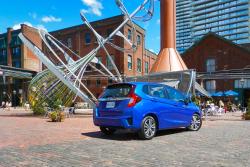 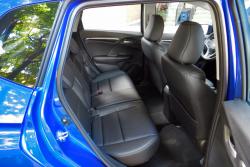 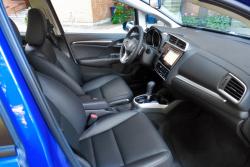 2015 Honda Fit, rear seats, front seats. Click image to enlarge |
The turning circle is tight enough for small spaces and the steering feels perfectly firm at low speeds. The Fit also now has a standard back-up camera across all trims.
The leather seats in the EX-L model add luxury to the interior, and the top trims also get a smattering of soft-touch material alongside the centre stack and over the cover directly in front of the passenger. The door trims including armrests, dash top and the console are all hard plastic though. The armrests in particular need more support. The steering wheel is a leather-look, but a brick-feel. It has no suppleness at all and the stitching is purely aesthetic. In any other car this might be a valid complaint, but at around $20K you get a hell of a lot of car, so I don’t think a little bit of scrimping on materials hurts.
I preferred the cloth seats to the leather, but both sets are well-shaped and comfortable. We spent over three hours in the saddle and found them comfortable the entire journey – a journey that included Toronto’s worst and most famous daily gridlock, the Don Valley Parking Lot.
You also get a spattering of faux aluminum trim to give a little texture to the cabin, and a handy centre armrest bin which is large enough to swallow an iPad. If you have iPhone as well you can can connect it via HondaLink to the seven-inch infotainment screen. Android phones and iPads are not yet supported.
HondaLink allows Apple users to mirror some apps in the screen, and gives access to navigation (via your data plan) for models from LX and up.
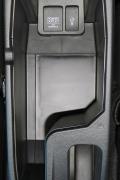 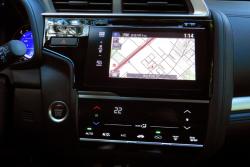 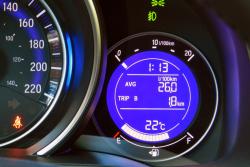 2015 Honda Fit centre console storage, navigation, fuel economy display. Click image to enlarge |
Base models get the luxury of a tuning and volume knob as well as a five-inch infotainment display, while LX models and up have the touchscreen-only seven-inch system. The touchscreen is still not up to par. Sure, the icons are clear and it’s easy to figure out, but the touch response is slow and inconsistent. Also it is infuriating that you can’t change stations/tracks without navigating back to the audio display and using the touchscreen. The steering wheel controls are great if you use presets only, but if you prefer to scroll through channels you’ll need to use the touchscreen.
The rest of the dials are wonderful. They’re clear, easy to read and the large central speedometer is ringed by the EcoAssist lights. Little strips of light glow blue or green depending on how economically you’re driving. To the right is a round TFT that has a permanent fuel gauge on the bottom and permanent instantaneous fuel readout at the top. It was a pleasant surprise to be able to see both average and instantaneous readouts at the same time, and kudos to Honda for giving this now-vital piece of information a full-time home.
  2015 Honda Fit. Click image to enlarge |
There is also a new top–level trim, the EX-L Navi which gives Fit leather for the first time. In fact, all of the Fit trims have been updated with more equipment added. The base DX trim actually drops in price by $140 to $14,495 while adding one-touch turn signal, LED rear brake lights, EcoAssist, USB/Aux input, rearview camera, driver-seat height adjustment, five-inch infotainment screen, keyless entry, Hill Start Assist, map lights, and Bluetooth as standard in 2015. As in previous years, it also comes with an expanded-view driver’s mirror, heated door mirrors, 15-inch steel wheels and carpet mats. The DX is only available in manual transmission.
The volume-leader LX trim is now $17,295 (up $140) in manual guise and $18,595 (up $240) for the CVT. New-for-2015 features on the LX include all those of the DX plus steering-mounted audio controls, a seven-inch audio display and heated front seats. Carryover features include an Econ button for CVT models, rear roofline spoiler, cruise control and air conditioning.
The Sport model has been replaced by EX which Honda calls their “style” model. It further adds a moonroof, chrome grille, chrome rear garnish, cargo cover, paddle shifters for the CVT and LaneWatch versus the 2014 model. Pricing has again grown by $140 and $240 to $19,195 (manual) and $20,495 (CVT). As in 2014 you’ll also get auto on-off headlights, 16-inch alloys and six speakers.
And finally, the all-new EX-L Navi model adds climate control, mirror-mounted turn signals, smart-start and entry, leather seats, XM radio and navigation. It brings the maximum price for the Fit up from $20,255 to $22,595, or $21,295 if you’re happy to do your own gear work.
  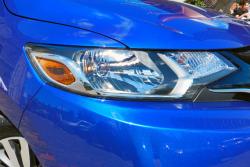 2015 Honda Fit taillight, side mirror turn signal, headlight. Click image to enlarge |
There are three new colours for the Fit with Aegean Blue Metallic, White Orchid Pearl and Mystic Yellow Pearl joining Crystal Black Pearl, Milano Red and Modern Steel Metallic in the Fit palette.
That would make the Fit a firm, fifth leg in their core lineup of Accord, Civic, CR-V and Odyssey. Honda says that the new plant in Celaya, Mexico, which already produces Fit and will soon produce the upcoming Honda HR-V will ensure a solid supply. It’s that lack of supply that they say has hampered the Fit’s expansion in North America, and Honda expects to sell around 14,000 units a year once Fit hits the salerooms in September.
To hit that target Honda is betting that the drop in cargo space is outweighed by the improvements in the features list, passenger room, fuel economy and overall driving experience.
I’d say that’s a fairly safe bet.
Pricing: 2015 Honda Fit
2015 Honda Fit DX: $14,495
2015 Honda Fit LX (MT/CVT): $17,295/$18,595
2015 Honda Fit EX (MT/CVT): $19,195/$20,495
2015 Honda Fit EX-L Navi (MT/CVT): $21,295/$22,595
Competitors:
Chevrolet Sonic
Hyundai Accent
Kia Rio5
Ford Fiesta
Mazda2
Toyota Yaris
Crash Test Results:
National Highway Traffic Safety Administration (NHTSA)
Insurance Institute for Highway Safety (IIHS)












































